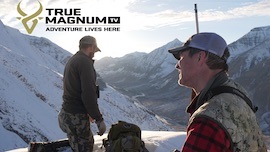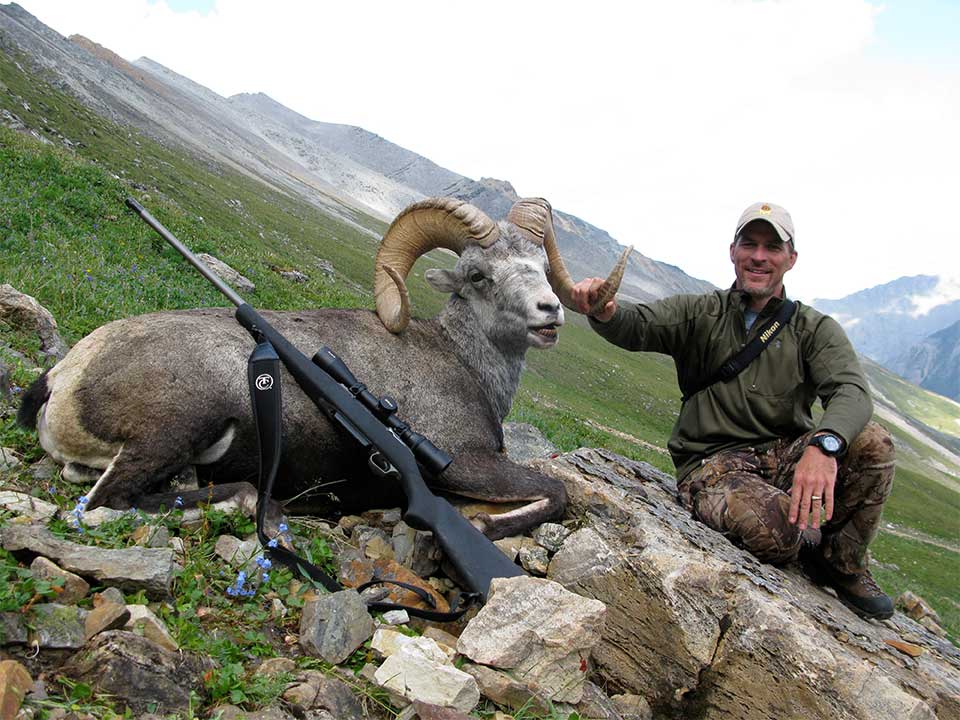Stone Mountain Adventure “When a Hunt Goes Perfect”
Posted by James Brion on Mar 11th 2020
“If we spook ‘em at least we have thirteen more days to pay for our sins,” exclaimed my guide Derrick Stevens. It was not a very re-assuring comment knowing that we were at the end of our cover and had no choice but to crawl on all fours for about 100 yards, totally exposed to the commanding view of the rams above. It had taken us four days of hard scouting, including 48 miles on horseback and a good amount of footwork to get to this point. The prospect of starting the process over to find another good ram in a Northern BC hunting area the size of Connecticut was a bit daunting. And with the hunt unfolding so smoothly up to now, I wondered if this was the point where our good luck would turn on us. It never goes this perfect, especially on a sheep hunt, I thought to myself…..
North American sheep are not hunted, they are accomplished. The amount of planning and preparation that goes into a sheep hunt is simply much different than any other. I entrusted Leif and Kellie Olsen and the Stone Sheep professionals at Stone Mountain Safaris near Toad River, British Columbia with that task.
The last sheep I had accomplished was a bighorn in my home state of Montana. Not a tag draw but a good old fashioned, do-it-yourself unlimited unit ram in 1996. Back then my preparation was no more than packing a backpack and walking out the door. Since turning 40……well, let's just say that getting in sheep shape has gotten more involved.
I arrived at Fort Nelson on July 27, five full days before the season opener. We spent the night in their stunning lodge surrounded by British Columbia wilderness, overlooking a 200 acre hayfield where they had just begun the process of rolling up the summer crop into large round bales. This would feed Stone Mountain’s stock for the coming winter. Their accomplished bush pilot, Dave Wilson, and an L-19 bird dog were hard at work stocking the camps and gearing up for the upcoming season. There was a buzz in the air. The hunting season was about to begin in earnest with the first hunt of the year.
The next day we met our guide, Derrick Stevens and the wrangler, Dan Wiebe at the trailhead. The horses were nearly packed and ready for the 20-mile ride to camp. I am only a moderately experienced mountain horseman. Hunting trips in Montana and Wyoming were the extent of my resume and they were not great experiences at that. My first 22 years were spent in the flatlands of Nebraska and though I had some experience rounding up cattle on the prairies, it was nothing that could prepare you for the extreme riding found in Northern BC. The most precarious horseback riding you’ll ever encounter. I spent a good amount of time that day looking past my stirrups to creek bottoms far below.
That evening we set up base camp at about 3000 feet. The “sweet spot” for Stone Sheep in this country is between 4500 and 7000 feet. In this early season, the rams would be found at the higher range in their bachelor groups and bedding high to escape the flies. So we had some serious climbing to do to get into sheep country. The plan was to branch out for the following three days, checking known summer sheep haunts for bands of rams.
We experienced a true taste of the wilderness on our first scouting day. No sooner had we tied up the horses at our first glassing location when our cameraman yelled, “Bear”. I looked up to see a cow and calf moose running right down the creek with a large male ‘griz’ in hot pursuit. The bear charged into the river and paralleled us at about 80 yards. When he crested the bank and spotted us, he turned and took a few steps in our direction. We both drew down on the bear as Derrick yelled him down. With his meal getting away, the Grizzly decided there wasn’t time to get serious and he wheeled and left. We worked our way up the canyon glassing as we went. When we returned to our horses that evening, we spotted our first two rams at two miles distant, perched on a spine at about 7000 feet. One ram appeared to be good but at that distance, there was no way to be certain.
The next morning, instead of getting a closer look at those sheep, Derrick decided to take us into another canyon, which generally held summer rams. Concerned, I asked, “Do you think we’ll see sheep?” “I’ll be shocked if we don’t”, Derrick replied. That confidence made the riding and climbing a little easier that day in anticipation of getting a closer look at this most majestic of North American big game animals.
I have hunted about half of the North American big game species and found the Stone Sheep is the most difficult to spot. Even though we were fairly certain that there were many in our valley, we didn’t pick a sheep out of the rocks all afternoon. “How long do we have to look to find em”, I poked at Derrick. “Till our eyes bleed, and then just a little longer”, he replied.
That evening sheep started materializing on the same rocks that we had been scouring all afternoon. One after another until there were a dozen rams and twenty ewes and lambs feeding on the green slopes below the talus two miles distant. We were having a hard time finding a legal ram, but then Derrick looked up from his spotter wide eyed and said, “There’s your shooter”. A large, dark charcoal and gray bodied, beautiful classic horned Stone Ram with lamb tips tipping straight out. He had good bases and carried his mass well. That night we rode back to base camp and got our stuff ready to spike out below the sheep the next day. We would live with the sheep from here on and hunt them on the opener.
Opening day broke with a new sense of urgency because on scouting days, time doesn’t matter. Now, we had another focus and mission. We were eager to get up the mountain and finally get a really close look at the ram.
……With our rams spotted and aged, there was nothing left to do but commence the long stalk. But we were faced with this dilemma: being exposed to four bedded rams at a distance of 800 yards, and we would remain exposed for 100 yards. Contemplating their nine power eye, we would be hiding nothing from the sheep. They would see it all. Our success or failure did not depend on whether or not they would see us, it was dependent on whether or not they would forgive what they saw. Our plan was to hunker down on all fours and slowly “graze” along, never moving straight at the sheep, but rather at an angle downhill until we were once again out of their sight; and of course, never allowing them to see an obvious human form.
Without a doubt this was the longest 100-yard crawl of my life. When I reached Derrick he said “I think we’ve gotten away with it. They are still bedded and don’t seem to be nervous. But now we can’t keep track of them either, so we need to hurry. We don’t want them getting up now to re-bed while we are on final stalk.” And if that wasn’t enough of a problem, there were about 30 other sheep and one mountain goat perched in and about the rocks and crevices around these rams. What’s more, our shooter wasn’t bedded with this band. We had no idea where the rest of the sheep, including our shooter, were bedded and it was likely that many would see our approach.
We hunched over and hustled over a couple more ridges then scrambled up a wash to our target rock, which we figured would put us within 300 yards of any of the rams. Derrick crawled to the rock first. As soon as he gave me the signal that he had eyes on the rams, I crawled up next to him and readied my Thompson Center Icon chambered in .300 Win Mag on the rock. There is a tremendous sense of accomplishment in that moment, when you have made a two-mile stalk right to your target. That sense of accomplishment then has to be tempered with some deep breaths, and mental games once your brain figures out that months of preparation have all come down to this. It took all the mental tricks I could muster to convince myself that this was just another shot. I mean, good grief, this is a Stone Sheep! I’ve made shots twice as long on other critters many times with total confidence and not the slightest hint of doubt. I have to admit, I was having a hard time with this one.
Derrick was focused on the four bedded rams that we had been watching during the stalk. They were below us and to the left. Derrick’s stalk had really gotten us the drop on those rams. As I peeked over the rock, I noticed a couple more rams directly in front of us. I put my EDG binos to my face and immediately recognized the big ram from our two prior days of scouting. I asked Derrick to confirm, which he quickly did. The ram climbed a rock and bedded, looking straight in our direction. How could we have gotten so lucky to have the one sheep we wanted out of 30 sitting right in front of us, almost by accident, I thought. This never happens. But now I had an unknown amount of time to wait for an ethical shot……and the mental torture continued. As it turned out, the ram, being on his own time, decided to bed down for a full 20 minutes. I felt like a placekicker being iced by 3 straight timeouts before attempting the game winning kick. I had all the time I needed to play out every possible scenario that could go wrong to spoil my “perfect hunt”.
When the ram finally got up, he checked the wind twice and seemed to be looking intently to see what it was that was peeking over the rock 264 yards distant. “Can I take him?” I whispered to Magnum Cameraman, David Sager. “Not yet, wait….wait….when he stops” David replied. The ram stopped. Immediately, punctuated with a 180 grain Accubond through the front shoulder as he quartered toward us. “Give him another”, Derrick said, but before I could feed the Icon another, the ram was tumbling off his bedding rock. It was all over and all on film. An accomplishment we had set out to achieve, but none of us were brash enough to expect.
“Luck is where preparedness meets opportunity”, and it all met up in that little valley at the top of the world on the opening day of British Columbia’s Stone Sheep season in 2010. What’s more, my perfect hunt was not over yet. On the ride out to base camp the following day, we took a beautiful lone black wolf at 347 yards. Derrick and I stared speechless for just a moment when the Accubond whomp echoed back from across the valley and the wolf fell over. We had just taken two of the most difficult of North America’s big game species in less than 24 hours. The silence was soon broken by cheers that could have been heard across the border into the Yukon.


